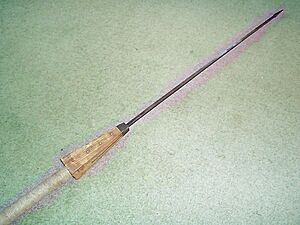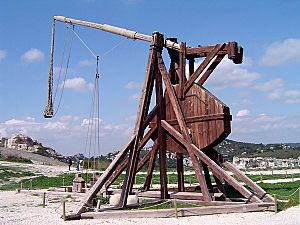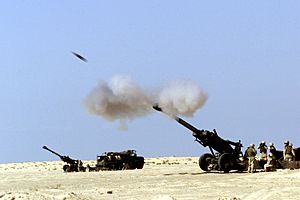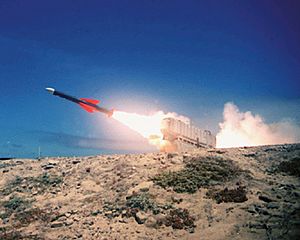Ranged weapon facts for kids
A ranged weapon is a tool used to hit targets from a distance. This means you don't have to be right next to someone to use it. Using a ranged weapon is often called shooting. These weapons usually work by launching a solid object, like a rock or an arrow. Sometimes, they can also shoot liquids, gases, or even beams of energy!
Ranged weapons give the person using them a big advantage. They can hit an enemy from far away, making it harder for the enemy to fight back. It also keeps the user safer, as they are not in close danger like in a hand-to-hand fight.
Sometimes, a weapon can be both ranged and used up close. For example, a spear can be thrown or used for stabbing. A knife can be thrown or used in a close fight. Even a rifle can be used to hit someone with its stock if they get too close!
Early ranged weapons included things you could throw, like darts and javelins. There were also elastic weapons like slingshots, bows, and crossbows. Bigger weapons like catapults and trebuchets were used to attack castles. These weapons were very powerful in ancient and medieval times. They let armies attack many times before the enemy could even get close.
After gunpowder was invented, firearms became the main type of ranged weapon. In modern times, ranged weapons include long-range cannons, rockets, guided missiles, and even drones. The "effective range" of a weapon is how far it can shoot and still cause damage. If a missile can be launched from so far away that the enemy can't shoot back, it's called a standoff missile.
Contents
Types of Ranged Weapons
Weapons from Ancient Times to the Middle Ages

- Hand-thrown weapons
- Thrown by hand:
- Bolas (ropes with weights)
- Darts
- Spears
- Throwing axes (like the Tomahawk)
- Throwing knifes
- Boomerangs
- With a tool to help throw:
- Atlatl (spear-thrower)
- Sling (to throw stones)
- Thrown by hand:
- Elastic weapons (using stretchy materials)
- Air-powered weapons
- Blowgun (shoots darts with breath)
- Explosive weapons (using gunpowder)
- Fire lance (early gun)
- Hand cannon (first handheld guns)
- Arquebus (an early type of rifle)
- Swivel gun (a small cannon that could turn)
- Rocket weapons
- Fire arrow (arrows with explosives)
- Siege weapons (used to attack castles)

Weapons from the Early Modern Period
- Air-powered weapons
- Airgun (uses compressed air)
- Explosive weapons
- Musket (a smooth-bore gun, common in armies)
- Pistol (a small, handheld gun)
- Blunderbuss (a short gun with a wide barrel)
- Wall gun (a very large musket, often used from walls)
- Field gun (cannons used on battlefields)
- Culverin (a long, light cannon)
- Hand mortar (a small, handheld mortar)
- Zamburak (a small cannon mounted on a camel)
- Siege cannon (very large cannons used to break down walls)
Weapons from the Late Modern and Today's Period
Most modern ranged weapons are either for direct fire (shooting straight at a target) or indirect fire (shooting over obstacles, like artillery). Some are small enough for one person, but many need a team to use.
- Small arms and light weapons
- Handguns:
- Revolver (a pistol with a rotating cylinder)
- Semi-automatic pistol (reloads itself after each shot)
- Long guns:
- Shotgun (shoots many small pellets)
- Rifle (has grooves inside the barrel to make bullets spin)
- Assault rifle (a common type of military rifle)
- Sniper rifle (for very accurate long-range shooting)
- Submachine gun (a small, automatic gun)
- Light machine gun (for continuous firing)
- Grenade launcher (shoots grenades)
- Handguns:
- Crew-served weapons (need a team to operate)
- Medium machine gun
- Anti-material rifle (for damaging equipment)
- Recoilless rifle (a gun that doesn't kick back much)
- Heavy weapons and vehicle-mounted systems
- Heavy machine gun
- Autocannon (a large, automatic cannon)
- Minigun (a machine gun with multiple rotating barrels)
- Artillery (large guns for long distances)
- Mortar
- Howitzer (a type of cannon that can shoot at different angles)
- Anti-tank gun (for destroying tanks)
- Tank gun (the main gun on a tank)
- Rocket weapons
- Rocket launcher (shoots rockets)
- Rocket-propelled grenade (a rocket for one person to carry)
- Multiple rocket launcher (shoots many rockets at once)
- Guided missiles (rockets that can change direction in flight)
- Air-to-air missile (from plane to plane)
- Surface-to-air missile (from ground to air)
- Anti-tank guided missile (for tanks)
- Ballistic missile (flies high into space before coming down)
- Cruise missile (flies low to the ground)
- Torpedo (a weapon that travels underwater)
- Flamethrower (shoots a stream of fire)
- Water cannon (shoots powerful jets of water)
- Aerial weapons
- Loitering munition (a drone that waits before attacking)
Future and Idea Weapons
- High-acceleration weapons (use strong forces to launch things)
- Railgun (uses electricity to launch a projectile very fast)
- Coilgun (uses magnetic coils to speed up a projectile)
- Directed energy weapons (use energy beams)
- Laser weapon (uses a powerful light beam)
- Particle-beam weapon (uses a beam of tiny particles)
- Microwave weapon (uses microwave energy)
- Sonic weapon (uses sound waves)
See also
- Trajectory of a projectile (the path a thrown object takes)
- Siege engine (machines used to attack castles)
- List of artillery
- List of missiles



